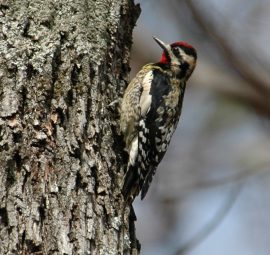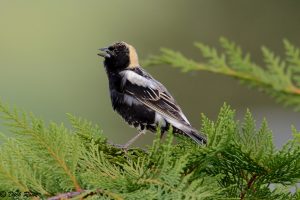By Eric Wallace

Misty Spruce-Fir forest habitat on Whitetop Mountain (CO Ashley Peele)
Wild and remote, Region 7 is a haven for adventurous Atlas volunteers. Here, regional coordinator Steven Hopp gives you the inside scoop on the area’s top spots to check out.
Spanning from Tazewell to Cumberland Gap, far southwest Virginia features some of the wildest, most rugged and beautiful scenery on the East Coast. With Grayson Highlands State Park to the east and Breaks Interstate Park to the west, the area is home to Virginia’s three highest peaks and the deepest canyon east of the Mississippi River.
For bird-loving hikers, Region 7 boasts what is probably the most celebrated section of the Appalachian Trail. The distinction has led to big-time trail culture in the tiny town of Damascus, which the Appalachian Trail Conservancy calls “the friendliest on the AT,” and the American Hiking Society recently crowned as “Trail Town, USA.”
For VABBA2 participants and interested birders, the area is one of our least covered. Should you decide to pay a visit, here’s a list of some of our favorite spots, including tips on where to eat, drink, and stay.
Whitetop Mountain, Wilson Creek
The state’s highest navigable road passes through the 200,000-acre

Yellow-bellied Sapsucker (CO Dick Rowe)
Mount Rogers National Recreation Area and concludes at the summit of Virginia’s second tallest independent peak, Whitetop Mountain. With an elevation of 5,220 feet, the area is like an ecological island of flora and fauna, and is listed as a National Audubon Society “Important Bird Area.”
“The area is special in that it marks the northern border of the southern Appalachian spruce-fir forest,” says VABBA2 Region 7 coordinator and New York Times bestselling author Steven Hopp. A relic of the last ice age, the forest type covers just over 100 square miles, and is considered the second-most endangered ecosystem in the United States. “It’s a great place to see high-elevation birds that are typically found only in northern hardwood forests.”
Whitetop is home to the only currently known breeding population of the Appalachian Yellow-bellied Sapsucker and other vulnerable species like the Northern Saw-whet owl, Winter Wren, and Red Crossbill. For a list of species spotted in the area, click HERE.
Clinch Mountain State Wildlife Management Area, Pounding Mill
A little easier to get to than Whitetop, the CMWMA spans four counties and is the second-largest wildlife management area in the Commonwealth. Additionally, its 25,477 acres are the most biologically diverse of all Virginia Department of Wildlife Resources holdings.
“The diversity comes from 4,700-foot mountains rising steeply from narrow valley floors with elevations of around 1,600 feet,” says Hopp. “There’s a lot of water in there too, including the 330-acre Laurel Bed Lake and Big Tumbling Creek.”
The area is home to plenty of walking trails, but Hopp’s favorite is the Panther Lick Trail, which he says guarantees high-elevation species, diversity of habitat, and total solitude.
For a list of birds spotted along Panther Lick, click HERE.
Burkes Garden, Burkes Garden
Ringed in by mountains, the unincorporated village of Burkes Garden is nestled within Virginia’s highest and most isolated valley. Four miles long and 8 miles wide, it is connected to the outside world by just one road, state Route 623.
“The elevation there is 3,000 feet, which is great for birding,” says Hopp. “Furthermore, it’s population is made up by around 300 Amish. The area is barely developed and is unlike anything you’ll find anywhere else in the state.”
With the AT passing nearby along the balds of Chestnut Ridge, a hike to the 4,409-foot Chestnut Knob Shelter offers spectacular views and excellent birding opportunities. Expect Dickcissels, Horned Larks, Loggerhead shrikes, Bobolinks, and many more.

Bobolink (CO Dick Rowe)
Here’s a Tip: There are no places to stay in Burkes Garden, so, if you’re going to visit, plan to camp or grab a hotel room in nearby Tazewell.
Breaks Interstate Park, Breaks
Located within the Jefferson National Forest on the border of Virginia and Kentucky, the 4,500-acre park is home to the “Grand Canyon of the South.” Carved by the Russell Fork River, the 5-mile-long horseshoe-shaped gorge is 1,650 feet deep, making it the deepest canyon east of the Mississippi.
“It’s probably the most isolated park in Virginia and offers awesome diversity,” says the VABBA2’s second most prolific e-birder, Kelly Krechmer. Last summer, Krechmer lived in the BIP while volunteering with AmeriCorps’s Interpretive Trail Program. “The park is home to the one of few breeding pairs of Peregrine Falcons in the state and is known for its rare Appalachian-breeding Swainson’s Warblers.”
Visitors can raft the Russell Fork and/or hike the park’s 25 miles of trails. There is a restaurant and water park on-site, as well as lodgings. If you’re going to stay, Krechmer recommends the newly installed lakefront cabins.
For a list of species spotted in the area, click HERE. To learn more about the park, click HERE.
EXPLORE MORE
Located 14 miles from historic downtown Abingdon, Damascus is a perfect basecamp for a weekend of birding adventure.
Eat / Drink
The Tavern, Abingdon —A German-meets-New-American local favorite housed in a beautiful historical building dating to 1789, the oldest in downtown Abingdon. Plates start around $25. Try the jambalaya, with its spice-hardy blend of sautéed crayfish, shrimp, bacon, Andouille sausage, vegetables and rice. www.abingdontavern.net
Harvest Table Restaurant, Meadowview —Owned by Steven Hopp, the Harvest Table boasts one of the nation’s most locally-sourced farm-to-table menus. Go for the seared duck breast with shitake mushrooms, pickled beat gastrique, sautéed cabbage and green beans. Plates from $20. www.harvesttablerestaurant.com
The Damascus Brewery, Damascus —This home-town brewery makes 45 different beers and keeps eight on tap. Provides live-music and a hardy dose of local flavor. Locals recommend the tart but gentle Honey Mango Sour. www.thedamascusbrewery.com
Stay
Crazy Larry’s Hostel, Damascus —If you’re looking for authentic AT-culture and/or a place to stay on the cheap, this is it. Situated on the main strip, it’s about a mile from the AT. Yard-camping, $30. Rooms, $40. www.facebook.com/CrazyLarrysHostel
The Old Mill Inn, Damascus —Overlooking Laurel Creek, this renovated mill dates to the early 19th century, has a working water wheel, and is located in the heart of town. Rooms have an upscale historical bed-and-breakfast style feel. Bonus: A fantastic restaurant + taproom on-site. From $139. www.damascusinn.com
Interested in learning more about the VABBA2 and/or birding in far southwest Virginia? On Saturday, May 12, Dr. Steven Hopp will lead a workshop at the 44th annual Mount Rogers Naturalist Rally. On Sunday, May 13, VABBA2 director Ashley Peele will lead a breeding bird inventory hike on Whitetop Mountain.
To read more about this and other SWVA events click HERE, or email Steven Hopp.
~Eric Wallace, VABBA2 Communications

